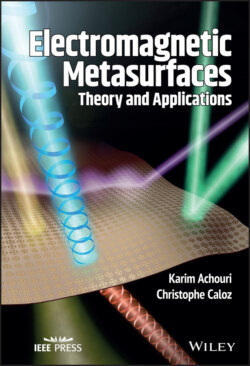Electromagnetic Metasurfaces

Реклама. ООО «ЛитРес», ИНН: 7719571260.
Оглавление
Christophe Caloz. Electromagnetic Metasurfaces
Table of Contents
List of Tables
List of Illustrations
Guide
Pages
Electromagnetic Metasurfaces. Theory and Applications
Preface
1 Introduction
1.1 Metamaterials
1.2 Emergence of Metasurfaces
Note
2. Electromagnetic Properties of Materials
2.1 Bianisotropic Constitutive Relations
2.2 Temporal Dispersion
2.2.1 Causality and Kramers–Kronig Relations
2.2.2 Lorentz Oscillator Model
2.3 Spatial Dispersion
2.4 Lorentz Reciprocity Theorem
2.5 Poynting Theorem
2.6 Energy Conservation in Lossless–Gainless Systems
2.7 Classification of Bianisotropic Media
Notes
3. Metasurface Modeling
3.1 Effective Homogeneity. 3.1.1 The Homogeneity Paradox
3.1.2 Theory of Periodic Structures
3.1.3 Scattering from Gratings
3.1.4 Homogenization
3.2 Effective Zero Thickness
3.3 Sheet Boundary Conditions
3.3.1 Impedance Modeling
3.3.2 Polarizability Modeling
3.3.3 Susceptibility Modeling
3.3.4 Comparisons Between the Models
3.3.4.1 Microscopic and Macroscopic Perspectives
3.3.4.2 Material Tensor Dimensions and Normal Polarizations
3.3.4.3 Uniform and Nonuniform Metasurfaces
3.3.4.4 Extension to Time-Varying or Nonlinear Systems
Notes
4 Susceptibility Synthesis
4.1 Linear Time-Invariant Metasurfaces. 4.1.1 Basic Assumptions
4.1.2 Birefringent Metasurfaces
4.1.3 Multiple-Transformation Metasurfaces
4.1.4 Relations Between Susceptibilities and Scattering Parameters
4.1.5 Surface-Wave Eigenvalue Problem. 4.1.5.1 Formulation of the Problem
4.1.5.2 Dispersion in a Symmetric Environment
4.1.6 Metasurfaces with Normal Polarizations
4.1.7 Illustrative Examples
4.1.7.1 Polarization Rotation
4.1.7.2 Multiple Nonreciprocal Transformations
4.1.7.3 Angle-Dependent Transformations
4.2 Time-Varying Metasurfaces. 4.2.1 Formulation of the Problem
4.2.2 Harmonic-Generation Time-Varying Metasurface
4.3 Nonlinear Metasurfaces
4.3.1 Second-Order Nonlinearity
4.3.1.1 Frequency-Domain Approach
4.3.1.2 Time-Domain Approach
Notes
5. Scattered Field Computation
5.1 Fourier-Based Propagation Method
5.2 Finite-Difference Frequency-Domain Method
5.3 Finite-Difference Time-Domain Method
5.3.1 Time-Varying Dispersionless Metasurfaces
5.3.2 Time-Varying Dispersive Metasurfaces
5.4 Spectral-Domain Integral Equation Method
Notes
6. Practical Implementation
6.1 General Implementation Procedure
6.2 Basic Strategies for Full-Phase Coverage
6.2.1 Linear Polarization
6.2.1.1 Metallic Scattering Particles
6.2.1.2 Dielectric Scattering Particles
6.2.2 Circular Polarization
6.3 Full-Phase Coverage with Perfect Matching
6.4 Effects of Symmetry Breaking
6.4.1 Angular Scattering
6.4.2 Polarization Conversion
Notes
7. Applications
7.1 Angle-Independent Transformation
7.2 Perfect Matching
7.3 Generalized Refraction
7.3.1 Limitations of Conventional Synthesis Methods
7.3.2 Perfect Refraction Using Bianisotropy
Notes
8. Conclusions
9. Appendix
9.1 Approximation of Average Fields at an Interface
9.2 Fields Radiated by a Sheet of Dipole Moments
9.3 Relations Between Susceptibilities and Polarizabilities
References
Index. a
b
c
d
e
f
g
h
i
j
k
l
n
o
p
q
r
s
t
u
w
WILEY END USER LICENSE AGREEMENT
Отрывок из книги
IEEE Press
445 Hoes Lane
.....
(2.40a)
(2.40b)
.....